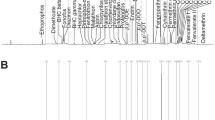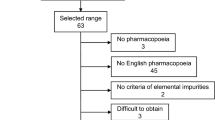Abstract
Purpose
The aim of this overview of systematic reviews is to summarise and critically evaluate the evidence from systematic reviews of the adulteration and contamination of herbal medicinal products (HMPs).
Methods
Five electronic databases were searched to identify all relevant systematic reviews.
Results
Twenty-six systematic reviews met our inclusion criteria. The most commonly HMPs were adulterated or contaminated with dust, pollens, insects, rodents, parasites, microbes, fungi, mould, toxins, pesticides, toxic heavy metals and/or prescription drugs. The most severe adverse effects caused by these adulterations were agranulocytosis, meningitis, multi-organ failure, perinatal stroke, arsenic, lead or mercury poisoning, malignancies or carcinomas, hepatic encephalopathy, hepatorenal syndrome, nephrotoxicity, rhabdomyolysis, metabolic acidosis, renal or liver failure, cerebral edema, coma, intracerebral haemorrhage, and death. Adulteration and contamination of HMPs were most commonly noted for traditional Indian and Chinese remedies, respectively.
Conclusions
Collectively these data suggest that there are reasons for concerns with regards to the quality of HMPs. Adulteration and contamination of HMPs can cause serious adverse effects. More stringent quality control and its enforcement seem to be necessary to avoid health risks.

Similar content being viewed by others
References
Hunt K, Ernst E (2010) Patients’ use of CAM: results from the Health Survey for England 2005. Focus Altern Complement Ther 15(2):101–103
Vocus/PRWeb (2012) http://www.prweb.com/releases/herbal_supplements/herbal_remedies/prweb9260421.htm. Accessed 9 March 2012
Ernst E, Pittler MH, Wider B, Boddy K (2006) The desktop guide to complementary and alternative medicine, 2nd edn. Elsevier Mosby, Edinburgh
Linde K, Knüppel L (2005) Large-scale observational studies of hypericum extracts in patients with depressive disorders—a systematic review. Phytomedicine 12:148–157
But PPH, Tomlinson B (1996) Adulteration of herbal products can cause poisoning. Br Med J 313:117
Ernst E (2002) Adulteration of Chinese herbal medicines with synthetic drugs: a systematic review. J Intern Med 252(2):107–113
Huang WF, Wen KC, Hsiao ML (1997) Adulteration by synthetic therapeutic substances of traditional chinese medicines in Taiwan. J Clin Pharmacol 37:334–350
Snyman T, Stewart MJ, Grove A, Steenkamp V (2005) Adulteration of South African traditional herbal remedies. Ther Drug Monit 27:86–89
Ang HH (2008) Lead contamination in Eugenia dyeriana herbal preparations from different commercial sources in Malaysia. Food Chem Toxicol 46(6):1969–1975
Ang HH, Lee KL (2006) Contamination of mercury in tongkat Ali hitam herbal preparations. Food Chem Toxicol 44(8):1245–1250
Miller LG, Hume A, Harris IM et al (2001) Adulteration: its various meanings. Pharmacotherapy 21(6):770–771
Zhang J, Wider B, Shang H, Li X, Ernst E (2012) Quality of herbal medicines: challenges and solutions. Complement Ther Med 20(1–2):100–106
World Health Organisation (2012) WHO guidelines for assessingquality of herbal medicineswith reference to contaminantsand residues. Available at: www.who.int/medicinedocs/index/assoc/s14878e/s14878e.pdf. Accessed 9 March 2012
Corrigan D (2003) European herbal medicines regulations. Focus Alt Complement Ther 8(2):169–170
Ernst E, Posadzki P, Lee MS (2011) Complementary and alternative medicine (CAM) for sexual dysfunction and erectile dysfunction in older men and women: an overview of systematic reviews. Maturitas 70(1):37–41
Oxman AD, Guyatt GH (1991) Validation of an index of the quality of review articles. J Clin Epidemiol 44(11):1271–1278
Ernst E (2000) Adverse effects of herbal drugs in dermatology. Br J Dermatol 143:923–929
Ernst E, Thompson CJ (2001) Heavy metals in traditional Chinese medicines: a systematic review. Clin Pharmacol Ther 70(6):497–504
Ernst E (2002) Toxic heavy metals and undeclared drugs in Asian herbal medicines. Trends Pharmacol Sci 23(3):136–139
Ernst E, Pittler MH (2002) Risks associated with herbal medicinal products. Wien Med Wschr 152:183–189
Ernst E (2002) Heavy metals in traditional Indian remedies. Eur J Clin Pharmacol 57(12):891–896
Ernst E (2003) Serious psychiatric and neurological adverse effects of herbal medicines—a systematic review. Acta Psychiatr Scand 108:83–91
Ernst E (2003) Serious adverse effects of unconventional therapies for children and adolescents: a systematic review of recent evidence. Eur J Pediatr 162:72–80
Gabardi S, Munz K, Ulbricht C (2007) A review of dietary supplement-induced renal dysfunction. Clin J Am Soc Nephrol 2(4):757–765
Ulbricht C, Costa D, Grimes Serrano J et al (2010) An evidence-based systematic review of spearmint by the Natural Standard Research Collaboration. J Diet Suppl 7(2):179–215
Ulbricht C, Weissner W, Hashmi S et al (2009) Essiac: systematic review by the Natural Standard Research Collaboration. J Soc Integr Oncol 7(2):73–80
Ulbricht C, Conquer J, Costa D et al (2011) An evidence-based systematic review of saffron (Crocus sativus) by the Natural Standard Research Collaboration. J Diet Suppl 8(1):58–114
Ulbricht C, Brendler T, Gruenwald J et al (2005) Lemon balm (Melissa officinalis L.): an evidence-based systematic review by the Natural Standard Research Collaboration. J Herb Pharmacother 5(4):71–114
Ulbricht C, Chao W, Costa D, Nguyen Y, Seamon E, Weissner W (2009) An evidence-based systematic review of green-lipped mussel (Perna canaliculus) by the Natural Standard Research Collaboration. J Diet Suppl 6(1):54–90
Basch E, Ulbricht C, Harrison M et al (2003) Alfalfa (Medicago sativa L.): a clinical decision support tool. J Herb Pharmacother 3(2):69–90
Saad B, Azaizeh H, bu-Hijleh G, Said O (2006) Safety of traditional Arab herbal medicine. Evid Based Complement Altern Med 3(4):433–439
Sweeney B, Vora M, Ulbricht C, Basch E (2005) Evidence-based systematic review of dandelion (Taraxacum officinale) by natural standard research collaboration. J Herb Pharmacother 5(1):79–93
Basch E, Conquer J, Culwell S et al (2012) Green tea (Camellia sinensis) Natural Standard Professional Monograph. Available at: http://www.naturalstandard.com/databases/herbssupplements/all/camellia.asp. Accessed 21 Jan 2012
Armbruester N, Bryan K, Costa D et al (2012) Cinnamon (Cinnamomum spp.) Natural Standard Professional Monograph, pp 1–70. Available at: http://www.naturalstandard.com/databases/herbssupplements/all/cassia.asp. Accessed 21 Jan 2012
Ceurvels J, Davis M, Clubb J et al (2012) Blue cohosh (Caulophyllum thalictroides) Natural Standard Professional Monograph. Available at: http://www.naturalstandard.com/databases/herbssupplements/all/caulophyllum.asp. Accessed 21 Jan 2012
McLaren J, Swift W, Dillon P, Allsop S (2008) Cannabis potency and contamination: a review of the literature. Addiction 103(7):1100–1109
Pittler MH, Ernst E (2003) Systematic review: hepatotoxic events associated with herbal medicinal products. Ailment Pharmacol Ther 18:451–471
Ernst E (2002) Adverse effects of unconventional therapies in the elderly: a systematic review of the recent literature. J Am Aging Assoc 25:11–20
Ernst E (2003) Cardiovascular adverse effects of herbal medicines: a systematic review of the recent literature. Can J Cardiol 19:818–827
Lynch E, Braithwaite R (2005) A review of the clinical and toxicological aspects of ‘traditional’ (herbal) medicines adulterated with heavy metals. Expert Opin Drug Saf 4(4):769–778
Wang GW, Hu WT, Huang BK, Qin LP (2011) Illicium verum: a review on its botany, traditional use, chemistry and pharmacology. J Ethnopharmacol 136(1):10–20
Hung SK, Hillier S, Ernst E (2011) Case reports of adverse effects of herbal medicinal products (HMPs): a quality assessment. Phytomedicine 18(5):335–343
World Health Organisation (2005) National policy on traditional medicine and regulation of herbal medicines. World Health Organisation, Geneva
Author information
Authors and Affiliations
Corresponding author
Appendix
Appendix
Rights and permissions
About this article
Cite this article
Posadzki, P., Watson, L. & Ernst, E. Contamination and adulteration of herbal medicinal products (HMPs): an overview of systematic reviews. Eur J Clin Pharmacol 69, 295–307 (2013). https://doi.org/10.1007/s00228-012-1353-z
Received:
Accepted:
Published:
Issue Date:
DOI: https://doi.org/10.1007/s00228-012-1353-z




